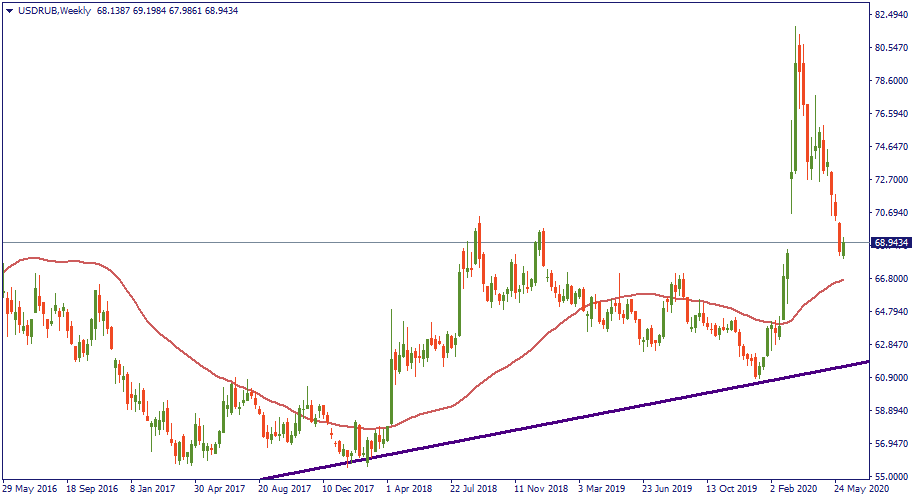
The G20 summit took place in Bali, Indonesia, on November 2022…

Don’t waste your time – keep track of how NFP affects the US dollar!
Data Collection Notice
We maintain a record of your data to run this website. By clicking the button, you agree to our Privacy Policy.

Beginner Forex Book
Your ultimate guide through the world of trading.
Check Your Inbox!
In our email, you will find the Forex 101 book. Just tap the button to get it!
Risk warning: ᏟᖴᎠs are complex instruments and come with a high risk of losing money rapidly due to leverage.
71.43% of retail investor accounts lose money when trading ᏟᖴᎠs with this provider.
You should consider whether you understand how ᏟᖴᎠs work and whether you can afford to take the high risk of losing your money.
Information is not investment advice
The current president assumed power in Russia in 2000 and stayed in power de facto during these 20 years. Leaving aside political questions, let’s focus on the economy and try to find a correlation between the price of oil and the price of the USD against the RUB.
Until 2015, while the oil price was above $20 per barrel and kept rising sometimes to cosmic highs like $140, the USD/RUB has been trading stable at 30. Eventually, the WTI oil price lost more than half its value dropping from $100 to $40. Simultaneously, the USD/RUB gained more than 100% flying from 30 to 70. Interestingly enough, both the oil price and the USD/RUB are now where they were in 2015 right before the “sudden” change. In any case, that was the end of Russia’s “gold era” of sky-high oil prices, and hence the RUB got substantially marked down.
The recent Russia-Saudi oil price war made the USD/RUB take yet a higher baseline level. The most recent spike in the USD/RUB is exactly where the WTI dropped to $20 (and even below 0 in some markets). In fact, it is visible that the shape of the chart after 2015 (marked by the green vertical line) is almost perfectly inverted between the oil price and the USD/RUB.
That’s why, specifically with the USD/RUB, one of the main fundamental factors defining this currency pair is the oil price. The higher it is – the better for the oil-exporting Russian economy, and hence, the stronger (or at least more stable) the RUB may be. This comes as a big facilitator to predict the USD/RUB: just keep your hand on the pulse of the oil price, and you will know where the USD/RUB goes. For a trader, what can be more convenient?

Source: tradingeconomics.com
The strategic outlook for the USD/RUB is an uptrend in any case. That is dictated by the supremacy of the American economy against the Russian – the latter simply cannot stand the competition and is doomed to lose, just as any developing economy with the currencies such as the MXN, BRL, and TRY. As we can see on the chart above, even after a bullish rally, an uptrend was rarely challenged – rather, tested, at times. For example, the years 2000-2015 can be taken as a period of a relative stability of the USD/RUB at or below the resistance of 30, with 2003-2008 showing a slow decline. That was ended with the mentioned plunge in the oil price that pushed the USD/RUB far beyond 30.
The weekly chart of USD/RUB below presents a volatile picture with an underlying upward trajectory. While the price may keep going down for a while, it is unlikely it would break the larger uptrend. More probably, it will come to test the uptrend’s bottom at 62-63 and will get back up to 69-70.
In any case, fundamentally speaking, there is little ground to expect the RUB to gain value against the USD in the long term. At maximum, it will stay stable where it is now. That should serve as an ideal background for trading that may rely on this guaranteed fundamentality. Hence, unless the oil price makes a substantial drop once again, one may safely buy the USD/RUB to see it grow in a few months or even weeks.


The G20 summit took place in Bali, Indonesia, on November 2022…

The deafening news shocked the whole world yesterday: the British Queen Elizabeth II died peacefully at the age of 96…

After months of pressure from the White House, Saudi Arabia relented and agreed with other OPEC+ members to increase production.

eurusd-is-falling-what-to-expect-from-the-future-price-movement

Greetings, fellow forex traders! Exciting news for those with an eye on the Australian market - the upcoming interest rate decision could be good news for Aussies looking to refinance or take out new loans. The Mortgage and Finance Association Australia CEO, Anja Pannek, has...

Hold onto your hats, folks! The Japanese yen took a nosedive after the Bank of Japan (BOJ) left its ultra-loose policy settings unchanged, including its closely watched yield curve control (YCC) policy. But wait, there's more! The BOJ also removed its forward guidance, which had previously pledged to keep interest rates at current or lower levels. So, what's the scoop? Market expectations had been subdued going into the meeting, but some were still hoping for tweaks to the forward guidance to prepare for an eventual exit from the bank's massive stimulus
Your request is accepted.
We will call you at the time interval that you chose
Next callback request for this phone number will be available in 00:30:00
If you have an urgent issue please contact us via
Live chat
Internal error. Please try again later